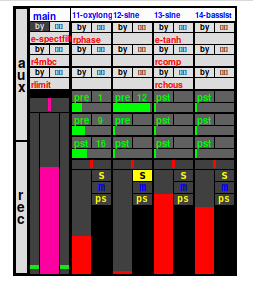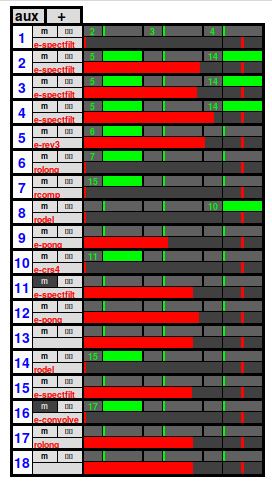mx

mx mixes all audio outputs from sound generating instruments and
provides a framework for using audio effects in netpd. Effects are organized
in libraries, which must be loaded as instrument in unpatch before their
effects can be used in mx. Effects may be used as inserts or auxilary
channels. mx as of today works with stereo channels and also the mixdown
result ist stereo (two channels).
Channel strip
Each instrument using the abstraction i2mx automatically creates a channel
strip in mx with the instance name of instrument labelled on top (click the
label to open the instrument).
Inserts
The light grey three slots are for loading effects as inserts
(ligh grey area).
Aux sends
The green sliders are auxilary sends. The number refers to the aux channel the
the signal is sent to, the sliders control the send amount. pst can be toggled
to pre and back to pst. pst means post fader, which means the signal after
panorama and level is sent to the aux channel. pre means pre fader, which
means the signal sent to the aux channel is tapped before the level and pan
controls.
Mixing control
The red horizontal slider is the panorama control, the bigger red vertical one
controls the level sent to the main mix. s is solo, m is mute, and ps is
private solo. Private solo acts only locally and is not propagated through netpd,
thus does not affect peer clients.
Main output
The pink slider on the left controls the output volume. mx is hard-coded to use
adc 1 + 2 of Pd. It also features a section with 3 slots for insert effects.
Aux section

The aux section is displayed by clicking the aux label on the very left in the
main window. Aux channels are created dynamically by clicking |+| in the aux
channel. Each aux channels features a slot for an effect and three pre-fader
sends that send the signal to higher number aux channels. This "downwards"
restriction prevents feedback loops and ensures that no additional latency
is added to the signal.
Recorder

The recorder is launched by clicking on the rec label in the main section.
It records the output (post-main-fader) of mx to a wav file with Pd's current
samplerate and a bitrate format of 16, 24, or 32bit-float. Since the recording
happens inside Pd, any glitches caused by audio drop-outs and similar are
eliminated in the resulting wav file.
